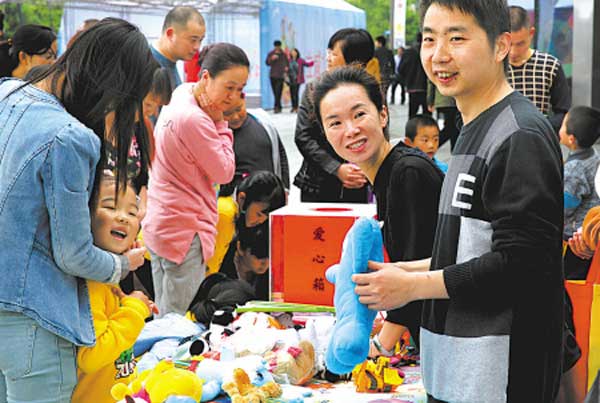NPC considers law aimed at charity transparency
(english.cri.cn) Updated: 2015-11-01 11:23
 |
|
A group of children from a kindergarten in Guangsha community of Jiangbei district and their parents take part in a charity flea market on the Jiangbei Wanda Plaza at the end of April 2014. The money raised was donated to elderly persons of no family in the community. Photo provided to chinadaily.com.cn |
"The current draft mainly regulates and supervised the formal charity organizations, activities and trust with charity aims, which is relatively narrow in legislation. Actually charity is diversified.
A lot of informal charity organizations and activities exist in daily life, for example the online charity activities and some unregistered micro charity groups. So we should add the new content into the charity law," said Sun.
Social concerns on charity fraud have become a media highlight after a recent case in east China's Anhui Province.
A local resident in Anhui, named Li Juan was seriously bitten by a dog in a kennel owned by her boyfriend, Zhang Hongyu.
However, Zhang falsely claimed on the Internet that Li was hurt when trying to save a girl from dogs and raised about 800,000 yuan in donations.
Later, media investigations exposed the fraud and police detained Zhang.
NPC delegate Li Andong suggested that harsher punishment should also be included in the charity law.
"This case is not individual and similar cases happen now and again. In order to improve the charity environment, we should prohibit and punish such donation cheat behaviors. The current charity draft has included some regulations but not in focus. So I suggest clearly defining and providing this in the law," Li said.
The draft under-debate also includes provisions to guarantee volunteer rights and ensure that charity groups, donors and beneficiaries enjoy taxation favors.
According to official numbers, China has nearly 3,000 registered nonprofit groups that manage charitable donations as of the end of 2012, up nearly 16 percent year on year.
- Top legislature considers draft charity law
- Draft charity law to improve transparency of Chinese charities
- Charity law should be extended to individuals
- Charity law should be extended to individuals
- A shining UK-China alliance: Lord Bates and his charity
- Charity run generates $13,315 for special-needs groups
- Looking to a new generation for regeneration
- New rocket readies for liftoff in 2016
- Foreign experts' access to visa eased
- NPC considers law aimed at charity transparency
- South China Sea ruling 'null and void', says ministry
- Couples face wait for 'second-child' policy
- New laws turn lens on domestic film industry
- Average Beijinger read 9 books in 2014: survey
- Top legislature considers draft charity law
- Senior Tibet legislator expelled from CPC, public office







